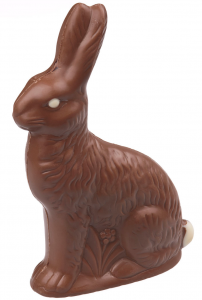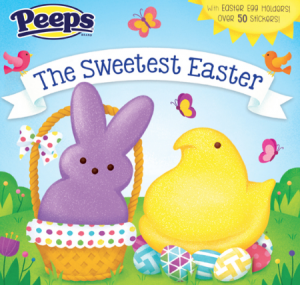Do you ever find yourself curious about information, steeping yourself in nonessential facts as if you’re about to compete in a Trivial Pursuit tournament? Apparently that’s one of my superpowers — seeking out and being able to recite useless information. Just ask my kids. They’ll vouch for me.

This is one of 90 million chocolate bunnies that will be produced this Easter (Photo from Wikipedia)
Anywho, I found myself using my superpower earlier this week as I read up on various and sundry nuggets of Easter wisdom. And since Easter is this Sunday, I thought I’d share a few of my favorites.
• About 90 million chocolate Easter bunnies are produced each year. That’s a lot of bunnies. Luckily, they multiply quickly. For the record, the correct way to eat a chocolate bunny is top down, beginning with the ears. That’s right, I said it.
• While 90 million chocolate bunnies may seem excessive, it pales in comparison to the 180 million real eggs Americans buy. While we’re on the subject, I miss dying eggs each year. When my daughter Hannah was young, we dyed at least three dozen eggs each year, employing various methods along the way, from the traditional PAAS egg-coloring kits to tie-dyed and glitter eggs. These days, I’d be lucky to talk Colton into dying a single egg. Alas, with Princess Squishy Face’s arrival, I’ll soon have a new egg-dying partner. But I digress.
• Back in the 70s, dyed chicks were among the most popular Easter gifts. Yep. Live chicks were sprayed with food coloring and sold as the perfect Easter gift. Who needs a chocolate bunny when there are live chicks to be had (rolls eyes). As you can imagine, many people cried fowl — pun intended — and the practice was discontinued. In recent years, though, the dyed chicks have once again grown in popularity. I ask you: was the real issue the fact that the chicks were dyed with food coloring? Or that the average American was ill-equipped to raise a live chick? As tiny, fuzzy and cute as they might be, they are destined to grow into full-sized hens. Every single time.

In every Easter basket . . .Peeps (Image from Peeps)
• No Easter basket is complete without a package or two of Peeps, evidenced by the fact that Americans purchase a whopping 700 million Peeps each year. The original Peeps chicks have been around since 1953. Today, they come in a variety of shapes, colors and flavors, are available for every holiday, and have established a full line of non-edible merchandise, like lip gloss, umbrellas, and apparel. Of note, the makers of Peeps also bring us Mike and Ike, Hot Tamales, Just Born Jelly Beans, and Goldenberg’s Peanut Chews.
• Kite-flying is a popular Easter tradition in various locales throughout the world, including Barbados, Guyana, and the Outer Banks of North Carolina. It’s long been a tradition in our home, as well. As far as I’m concerned, you haven’t lived until you’ve experienced the crushing disappointment of a flimsy piece of balsa wood snapping in two, or the stunning devastation of kite string breaking, sending your brand new kite into the atmosphere, never to be seen again. If you haven’t purchased kites for your kids, stop what you’re doing and purchase a couple now. I’ll wait right here.
• The annual White House Easter Egg Roll dates back to 1878, when President Rutherford B. Hayes opened the grounds to children. The story goes that they’d been loitering on the other side of the fence, looking for a place to roll their eggs, and the president said, “Hey, come on in!” Or something like that. These days, the egg roll is attended by some 30,000 children each year, beginning at 7:30 a.m. on Easter Monday, and concluding at 6:45 p.m. In order to participate, families sign up via an online lottery.
The event includes egg hunts and rolls, live entertainment, video games, tennis, and soccer. If you can’t be there in person, commemorative eggs are available for purchase at this website.
• Pretzels were the original bread of Lent. Because the bread could be made with nothing more than flour, water, and salt, it was perfect for the fasting season when foods like eggs, meat, butter, and other real food were off limits. An Italian monk is credited with creating the shape we know today, which is said to resemble the crossed arms of someone praying. Although most of us eat pretzels year-round, some places in Europe serve them only between Ash Wednesday and Easter Sunday.
And now you know. There you have it. Cool things to know as you celebrate this Easter Sunday — or anytime the subject of Easter comes up during a game of Trivial Pursuit. You’ll be unstoppable. Just ask my kids.

Beth Underwood is an award-winning journalist whose work has appeared in numerous newspapers and magazines. She shares stories of everyday life that entertain, inspire, and encourage others. Her books include Gravity, a narrative nonfiction account of a small group of Tennessee National Guardsmen, and Talk Bourbon to Me, a lighthearted look at Kentucky’s native spirit. Drop her a line at beth@bethwrightunderwood.com, or visit her website at bethwrightunderwood.com.
























